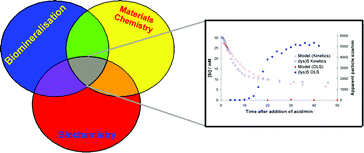Towards an understanding of (bio)silicification: the role of amino acids and lysine oligomers in silicification
Abstract
In order to understand the role that proteins play in the generation of well regulated biosilica structures we need to understand the contribution of the components, singly and in combination. To this end we have performed a systematic study of the effect of amino acids and small peptide oligomers on silica formation from aqueous solution. Silicas produced from a potassium silicon catecholate salt at ca. pH 7 in the presence of the amino acids (Gly, Arg, Asn, Gln, Glx, Ser, Thr, Tyr, Pro, Ala, Lys) at a 2 Si : 1 amino acid molar ratio have shown that these amino acids affect the kinetics of small oligomer formation, the growth of aggregate structures and the morphology and surface properties of the silicas produced. The effects seen during the early stages of oligomer formation carry through to the properties of the particles and aggregates produced after extended periods of reaction. The behaviour of the amino acids relates to the pI and hydrophobicity of the individual amino acids. The presence of the nitrogen containing amino acids generates larger particles and the presence of amino acids containing hydroxyl and hydrophobic groups generates silicas with smaller particles than are produced for silicas produced in the absence of amino acids. An extensive study of the effect of the number of lysine and glycine units per peptide was also performed (for lysine, 1–5 and ca. 150 and for glycine, 1,4,5). Increasing the number of glycine units per additive molecule had little effect on the kinetics, aggregation, sample morphology, surface area and porosity of the silicas produced. A distinct relationship between the number of lysine units per additive molecule and an increased rate of oligomer formation, aggregate growth and a reduction in silica surface area and broadening of pore sizes was observed. A distinct change over in behaviour, particularly in regard to the porosity characteristics of the silica produced was noted for between (lys) 3 and (lys) 4 as well as this being the smallest size of peptide that was incorporated into the siliceous material formed. Aggregation was observed to accelerate exponentially over the full range of lysine oligomers used. Consecutive sequences of the same amino acid residues were shown to produce effects much larger than the sum of the effects of the individual residues, and at extremes mediate macroscopic morphological changes. The consequences of these findings for biosilicification are discussed. It is clear that all amino acid functional groups in proteins that are accessible to silica during the stages of formation from orthosilicic acid through to the final material have a role to play in determining the physical nature and structure of the material that forms.

- This article is part of the themed collection: New developments in bio-related materials

 Please wait while we load your content...
Please wait while we load your content...